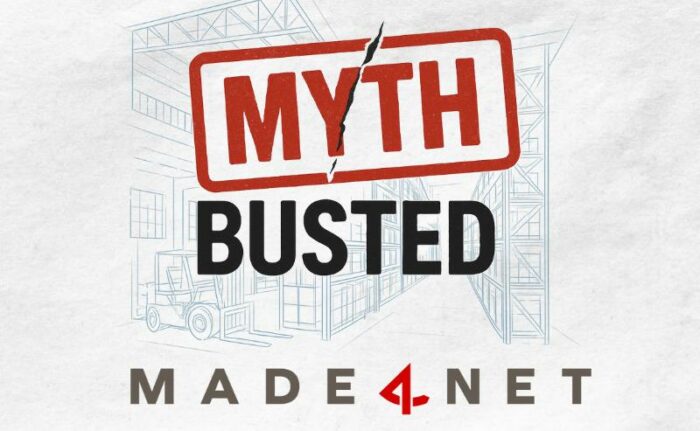
Warehousing is more than just storing products—it’s a strategic component of supply chain management that directly impacts efficiency, customer satisfaction, and cost control. Acting as the central hub between production and final delivery, warehouses are responsible for inventory accuracy, order fulfillment, and ensuring the right products reach the right place at the right time. To manage these responsibilities effectively—especially at scale—companies rely on advanced Warehouse Management Systems (WMS).
In this article, we’ll cover:
- What is Warehousing in Supply Chain Management?
- Why is Warehousing Important for Supply Chain Management?
- The 5 Types of Warehousing
- What are the Key Elements of Warehousing in Supply Chain Management?
- Common Challenges of Warehousing
- 7 Warehousing Best Practices
- Benefits of Effective Warehousing in Supply Chain Management
What is Warehousing in Supply Chain Management?
Warehousing in supply chain management is the strategic storage and handling of goods within a facility, ensuring products are efficiently received, stored, and dispatched to meet customer demand. It’s not only about storing items; it’s about optimizing the flow of goods to enhance overall supply chain performance, making it a cornerstone of a resilient supply chain.
The 5 Types of Warehousing
Just like there are different kinds of warehouse management systems (WMSs), there are varying kinds of warehouses. Here are 5 common types of warehousing, each serving a unique role in supply chain management:
- Distribution Centers: These are high-volume facilities focused on the rapid movement of goods. They store products for a short time before distributing them to retailers, wholesalers, or customers. Speed and efficiency are key.
- Public Warehouses: Available for rent by businesses on a short- or long-term basis, public warehouses are typically used by small to mid-sized companies that don’t own their own storage space. They are cost-effective and flexible.
- Private Warehouses: Owned and operated by a single company, private warehouses offer greater control over operations, inventory, and security. They’re often used by large retailers, manufacturers, or e-commerce businesses.
- Cold Storage Warehouses: Designed for perishable goods, these temperature-controlled facilities are essential for industries like food, pharmaceuticals, and biotechnology. They help maintain product integrity and shelf life.
- Automated Warehouses: These tech-enabled facilities use robotics, conveyor systems, and software (like advanced WMS) to manage inventory with minimal human intervention. They improve accuracy, speed, and labor efficiency.
What are the Key Elements of Warehousing in Supply Chain Management?
While each industry will have a different set of needs, there are several key elements of warehousing in supply chain management, which together ensure efficient, accurate, and cost-effective movement of goods:
- Inventory Management: Accurately tracking, storing, and rotating stock is essential. Proper inventory management reduces stockouts, overstock, and shrinkage, ensuring that the right products are available when needed.
- Storage Systems: Organized, optimized storage—whether it’s pallet racking, shelving, or automated systems—maximizes space utilization and ensures easy access to products for faster picking and fulfillment.
- Order Fulfillment: Warehouses play a critical role in picking, packing, and shipping orders. Efficient fulfillment processes directly impact customer satisfaction and delivery speed.
- Technology & Automation: Advanced systems like Warehouse Management Systems (WMS), barcode scanners, RFID, and automation technologies improve accuracy, visibility, and efficiency across all warehouse operations.
- Labor Management: Workforce planning, task assignment, and productivity tracking are key to running a high-performing warehouse. Labor management tools help balance workloads and control costs.
- Layout & Design: A well-planned layout supports smooth workflows, minimizes travel time, and adapts to volume fluctuations or SKU complexity.
- Security & Safety: Warehouses must safeguard goods and personnel. This includes physical security (like surveillance and access control) and compliance with OSHA and other safety regulations.
- Transportation Coordination: Warehouses often serve as the handoff point to carriers. Close coordination with transportation ensures timely shipping, optimized routes, and accurate documentation.
These elements work together to create an efficient system that allows products to move seamlessly through the supply chain. However, without the proper checks and balances in place, warehousing can become burdensome.
Common Challenges of Warehousing
Warehousing plays a critical role in supply chain management, but it also comes with a range of common challenges that can hinder efficiency and performance. One of the most persistent issues is poor inventory visibility, which can lead to stock discrepancies, overstocking, or stockouts that impact customer satisfaction. Labor shortages and high turnover rates add complexity, making it difficult to maintain consistent productivity and meet service levels, especially during peak seasons. Inefficient layout and space utilization can create bottlenecks and limit capacity, while outdated technology or lack of system integration can slow down operations and prevent real-time decision-making. Additionally, rising operational costs—from labor and utilities to transportation and storage—put pressure on profit margins. Managing these challenges effectively requires a strategic approach, modern tools, and a continuous focus on process improvement.
7 Warehousing Best Practices
Warehousing Best Practice #1: Implement Advanced WMS
The role of an advanced WMS has never been more critical. Today’s WMS solutions are designed to tackle operational inefficiencies, control rising costs, and uphold accuracy and customer satisfaction across complex supply chains. Key capabilities such as task interleaving, labor management, cycle counting, cartonization, omnichannel fulfillment, and cloud-based access enable warehouses to operate with greater precision and speed. A best-in-class WMS must not only deliver these advanced features but also offer the agility and scalability required to keep pace with evolving business demands.
Warehousing Best Practice #2: Optimize Storage Layout
Warehouse layout plays a significant role in warehouse efficiency. Optimizing the layout of storage zones, workstations, and aisles will go a long way in improving the amount of time it takes to fulfill orders. For example, a simple change like placing high-demand items closer to the shipping area can help you expedite order fulfillment.
Warehousing Best Practice #3: Order Picking Optimization
Order picking is one of the most labor-intensive and time-sensitive processes in the warehouse, and optimizing it is key to speeding up fulfillment. By organizing efficient pick paths that minimize travel time and reduce backtracking, teams can move faster and with fewer errors. Techniques like batch picking allow a single picker to fulfill multiple orders at once, increasing throughput. When powered by real-time data and intelligent software, pick paths can dynamically adjust to changes in order priority or inventory location, making operations more responsive and efficient.
Warehousing Best Practice #4: Cross-Docking Strategies
Functional cross-docking helps to eliminate prolonged warehousing, reducing warehouse costs while expediting the flow of goods through your supply chain. The goal is to move products directly from the inbound receiving area to outbound shipments with the shortest amount of storage time. Cross-docking is an essential strategy for optimizing your supply chain responsiveness.
Warehousing Best Practice #5: Regular Training Programs
Well-trained employees are essential to warehouse safety, efficiency, and productivity. From operating equipment to following safety protocols and executing optimized workflows, proper training minimizes errors and reduces downtime. Ongoing training ensures your team stays current with the latest best practices and technologies, building a workforce that’s not only capable but agile. By making training a priority, operations run smoother, risks are reduced, and employees are empowered to perform at their best.
Warehousing Best Practice #6: Continuous Improvement
A culture of continuous improvement ensures your warehouse stays agile in the face of market shifts and technological advancements. By taking a data-driven approach and leveraging performance metrics, employee feedback, and industry best practices, you can pinpoint what’s working and where there’s room to improve. Regular assessments, paired with an open forum for employees to share ideas and insights, offer a clearer view into day-to-day operations and unlock opportunities for operational refinement.
Warehousing Best Practice #7: Warehouse Automation
Warehouse automation has been a game changer in the supply chain world. Robotics, automated guided vehicles (AGVs), conveyor systems, and other advanced technologies have revolutionized how warehouses operate. The key is to identify the automation tools that align with your operational needs, not just the flashiest options on the market. The right-fit automation helps reduce lead times, prevent employee burnout, and drive greater speed and accuracy across your warehouse.
Benefits of Effective Warehousing in Supply Chain Management
Effective warehousing delivers numerous benefits in supply chain management, starting with improved inventory accuracy. This provides real-time visibility into stock levels and helps reduce stockouts, overstocking, and costly order errors. It also enables faster order fulfillment by supporting streamlined picking, packing, and shipping processes, resulting in quicker deliveries and higher customer satisfaction.
Better space utilization is achieved through optimized storage layouts and slotting strategies, allowing operations to handle more inventory without expanding the physical footprint. Increased labor efficiency comes from clear workflows, defined roles, and automation that reduce manual effort and boost productivity, especially during peak periods.
Efficient warehousing enhances the customer experience by ensuring orders are accurate and delivered on time, building trust and loyalty across the supply chain. Additionally, it offers greater flexibility and scalability, enabling operations to quickly adapt to changing demand, product mix, or supply chain disruptions without sacrificing performance.
By minimizing waste, improving accuracy, and optimizing labor, effective warehousing helps reduce operational costs significantly over time. Finally, a well-managed warehouse strengthens supply chain resilience by acting as a stabilizing force that improves visibility and control, particularly during disruptions or market shifts.
Unlocking Efficiency and Resilience Through Smarter Warehousing
Warehousing is more than just storage—it’s a strategic driver of supply chain success. From improving inventory accuracy and space utilization to adopting advanced WMS technology and automation, effective warehousing ensures operations run efficiently and customers stay satisfied. By applying best practices and proactively addressing common challenges, businesses can lower costs, boost performance, and build a more agile, resilient supply chain. Whether you’re looking to optimize an existing facility or design one from the ground up, our experts are ready to help transform your warehouse into a competitive advantage. Reach out today to learn how we can help you lead the way.


